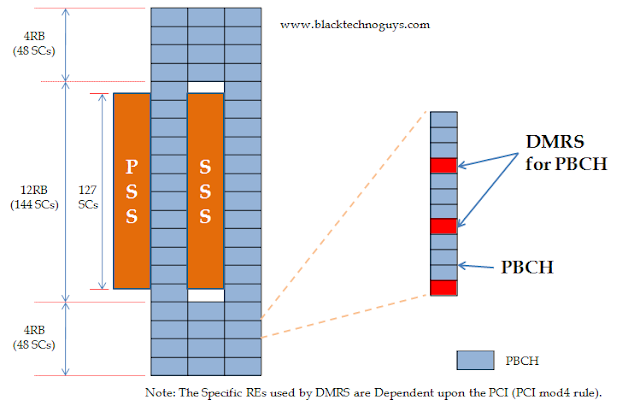Synchronization Signal Block
Home LTE NB-IoT 5G(NR-NSA)
The SS Block or SSB refers to the synchronization
signal block, which actually refers to the synchronization or PBCH block as the
synchronization signal and the PBCH channel are always packaged together.
The
SSB is a key part of beam management. To enable device to find a cell while
entering a system, as well as to find new cells when moving within the system a
synchronization signal consisting of PSS and SSS is periodically transmitted on
the downlink from each NR cell.
Thus PSS, SSS along with PBCH can jointly be
referred as SS Block. Thus we can say that SSB consists(4 OFDM symbols) of following parts:
Primary synchronization
signal (PSS) (127 Subcarriers) (1st OFDM symbol out of 4 OFDM symbols)
Secondary synchronization
signal (SSS) (127 Subcarriers) (3st OFDM symbol out of 4 OFDM symbols)
Physical broadcast channel
(PBCH) ( 2nd,3rd and 4th OFDM symbols)
Before learning more about SSB let us know about
synchronization:
So basically synchronization process is a process in
which a mobile terminal obtains the time and frequency of the wireless network
and is also a pre-requisite for the terminal to access the network.
The
terminal needs to know on which frequency and at what time the network sends
the message; this helps to receive the information correctly sent by the
network.
The synchronization process is a series of god operations for the
terminal to know the frequency and time information. As we know that the
transmission direction is known as uplink and the reception direction is called
as downlink.
Thus there are two types of synchronization, one is uplink
synchronization and the other is known as downlink synchronization.
Downlink synchronization: The UE detects the frame
boundary and symbol boundary. This detection process is implemented by SSB.
Uplink synchronization: The UE determines to determine
which time period is to transmit data.
Generally, the gNodeB needs to process
multiple UEs. The network side must ensure that each UE's uplink signal arrives
at the network for a common time (the network has to ensure that the uplink
signal from every UE should be aligned with a common receiver timer of the
network.), this is called the RACH procedure.
Difference between LTE sync signal and 5G sync signal:
The generation method is
different. The PSS in LTE is a Zadoff-Chu sequence of length 62; and the PSS in
NR is an m sequence of length 127.
The SSS in LTE is an m
sequence of length 62, while the SSS in NR is a gold sequence of length 127.
The number of PCI is
different. 504 PCI is defined in LTE, which is divided into 168 groups,
corresponding to 168 SSSs; each group contains 3 cells, corresponding to 3
PSSs.
NR defines 1008 PCIs, which
are divided into 336 groups, corresponding to 336 SSSs; each group contains 3
cells, corresponding to 3 PSSs.
The Synchronization signal time domain and
frequency domain position are different in both.
The frequency domain and time domain
positions of LTE PSS, SSS and PBCH are fixed in the system, always occupy the central frequency part of the system
bandwidth. PSS and SSS and PBCH do not have a strict binding relationship.
However, in 5G, PSS, SSS and PBCH are bound
together, known as SSB.
The subcarrier spacing of
different LTE subcarrier spacing is fixed to 15k, whereas the PBCH subcarrier
spacing in NR varies according to the frequency band.
5G synchronization process :
It is precisely due to the difference in
synchronization signals between NR and LTE that its synchronization process is
also different from LTE.
Beam-forming is commonly used in NR, and the
synchronization signal SSB is transmitted on different beams. Therefore, one
goal of the Synchronization process is to find the optimal beam. This process
is done by determining the SSB's index.
In the 5ms period, the index of the SSB and the beam
are in a one-to-one correspondence. By determining the index of the optimal
SSB, the optimal beam direction can be found.
By determining the frequency domain position of the
SSB, it can be based on other parameters (k_ssb, NCRB^{SSB} etc). Get the location of pointA to achieve
management of BWP.
In Upcoming Part we will learn more about SSB and SSB interview
question and its answer. And for more learning please go through our 5G and LTE
page.
Stay tune for more Update…………………
Pinal Dobariya…
Reference:
1) 3GPP TS 38.211,
2) 3GPP TS 38.212,
3) 3GPP TS 38.213,
4) 3GPP TS 38.331, 38.300
5) TR 38.912
6) https://blog.csdn.net/qq_44113393/article/details/89844595




Hello Pinal,
ReplyDeleteHow 5G UE searches for the SS Block in frequency domain? It could be 100s of MHZ...In LTE, the BWs are fixed and known so easy for UE to go center of 1.4 MHZ to do search and find out PSS, SSS and PBCH, etc...
In SA mode, 5G UE searches the GSCN raster for SS Block.
Delete